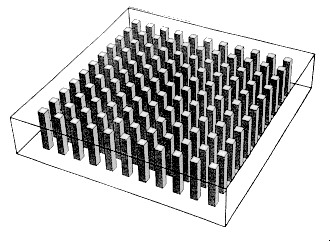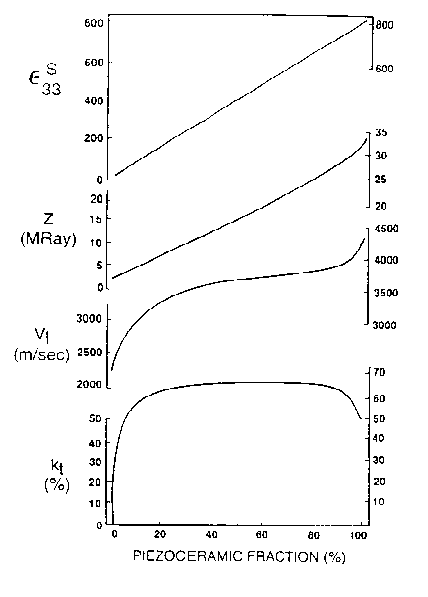 |
Fig. 1 Schematic representation of a piezo-composite plate with a 1-3 structure - After W.A. SMITH |
1-3 Piezo-composite materials
The structure of these materials, illustrated on the table 1, is made of thin ceramic rods (which present a mechanical continuity following one dimension of the space) embedded into a polymer matrix (which present a mechanical continuity following three dimensions of the space). Used as plates and equiped of electrodes on their main sides, these materials offer many advantages compared with piezo-electrical transducers generally used in the field of Non Destructive Testing.
| Material | Lead metanobiate | Lead zirco-titanate PZT | PVDF,PVDF - TrFE | 1-3 composite |
| Acoustical impedance (Mray) | 20 | 30 - 32 | 4.5 | 8 - 12 |
| Coupling coefficient | 0.3 | 0.45 - 0.5 | 0.2 - 0.3 | 0.5 - 0.7 |
| Dielectrical constant | 300 | 250 - 2000 | 6 | 200 - 600 |
| Density (g/cm3) | 6.2 | 7.8 | 2 | 3.5 - 4 |
Table 1 : Comparative chart of the electroacoustical properties for different piezo-electrical materials
The physical properties of the piezo-composite materials, particularly their dielectric, elastic and piezo-electric properties, depend on the properties of the constituent materials, on the relative proportion of these materials and also on geometrical parameters of the microstructure. In practice, the microstructure of the material is defined so that all the waves subject to excitation could have a wavelength higher than the microstructure itself. If this condition is respected, the piezo-composite material behaves like an homogeneous material which could be described with simple parameters comparable to classical material parameters :
 |
Fig. 1 Schematic representation of a piezo-composite plate with a 1-3 structure - After W.A. SMITH |
The variation laws of the main parameters of the piezo-composite materials can be modelized. The figure 2 presents these variation laws for the following parameters : dielectric permitivity , acoustical impedance Z, longitudinal wave velocity VL, electromagnetic coupling coefficient kt, according to the volume of ceramic material within the composite. It is particularly interesting to consider the variation of kt which constitutes the most important parameter in so far as it shows the capacity of the piezo-composite material to turn reciprocally electrical energy into acoustical energy. For a 1-3 piezo-composite, kt is higher than the one of the constituent ceramic material in a large range of volume. This surprising property comes from the effect of release of the lateral constraints within the ceramic bars which provides a best ability to transform energy than the ceramic in solid plate.
 |
fig. 2 Variation of dielectric constant acoustical impedance , velocity VL, coupling coefficient kt as a function of volumic fraction of PZT ceramic - After W.A. SMITH |
Characteristics of 1-3 Piezo-composite materials
The properties of these materials imply a certain number of specific characteristics as :
We have just listed the main properties of the transducers using piezo-composite technology. Specific properties have also been developped in the field of withstanding in power, temperature or for the realization of very small or very large transducers.